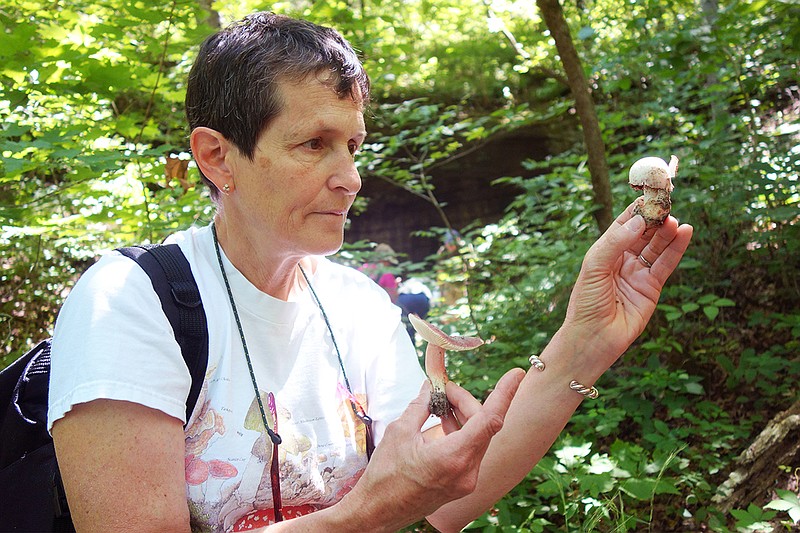DANVILLE, Mo. - Hikers at Graham Cave State Park peered at the trees and ground as they walked. Suddenly, one of them pounced.
"I found one," a kid called, holding a mushroom aloft.
"Oh, that's beautiful," said fungus researcher and University of Missouri Jeanne Mihail as she hustled over.
During the Saturday guided hike along Fern Ridge Trail, Mihail taught participants how to see the world the way she sees it: Interconnected and full of fungi.
"Without fungi, this whole system would stop," she said, gesturing to the forest.
Fungi, she explained, play many roles in the environment. Some infect and kill plants, others break down organic matter and still others help redistribute nutrients between plants.
Early in the hike, the group spotted some tiny slime mold on a fallen tree trunk that had been broken down until it was practically mulch.
"The biggest thing that fungi do for us is what we see right here," Mihail said. "Fungi recycle."
By digesting fallen logs, fungi release nutrients into the soil. The decayed wood also retains water in the soil so plants can use it. Lichens also serve a similar function.
"A lichen is a permanent partnership between a fungus and an algae," Mihail said.
Lichens growing on rocks secrete an acid that slowly dissolves the rock's surface, creating new soil.
And, of course, fungi are themselves a food source for bugs, animals and people, though Mihail advises extreme caution when mushroom-hunting. A good guidebook is a must, but many edible mushrooms have deadly lookalikes. Advice from an expert is advisable.
"I don't collect mushrooms for food very often, if that tells you anything," she said.
Fungi also have unexpected uses. For example, puffballs - those usually round, usually brown or white fungi that let loose puffs of spores when bumped - can be used as a styptic.
"If you have a nosebleed, you can sniff the spores and stop the bleeding," Mihail said. "Don't do that if you have a mold or spore allergy."
Some of the fungi the group found looked like fuzzy threads snaking along the underside of fallen branches. Mihail said these are called "cords," and are a fungus' way of getting from one food source to the next. In fact, what we see as fungi are just the tip of the iceberg.
"Most people, when they think of fungi, they think of what's on my shirt," Mihail said.
Her shirt was covered with classic mushrooms, each with a cap and stipe (stem).
But, she explained, those mushrooms are just the fruit of a fungus, like an apple is just the fruit of an apple tree. Fungi mostly live underground or hidden within bark.
And speaking of bark, Mihail had some bad news for tree-lovers.
She said if you see fungi growing out of a tree in your yard, it's probably too late to save it. Typically, the fungi have already rotted away the tree's heart before becoming visible on the outside.
"If that tree with the shelf fungus on it is next to your garage, you might think about having that tree removed," Mihail said.
By the end of the hike, the group had spotted about a dozen species of fungus, including some young edible chanterelles. Participants said they learned a lot along the way.
"Nature is just so amazing," hiker Karen Elwood said. "And the more you get out into it and really look, the more you'll see."
Graham Cave State Park's superintendent Cade Harp added the park will host further guided hikes in the future.
"Ecologically, this park is really unique," he said.
Learn more about the park at on.mo.gov/2te0QAk.

